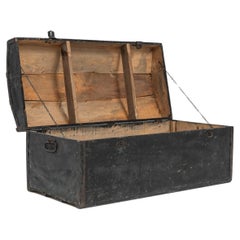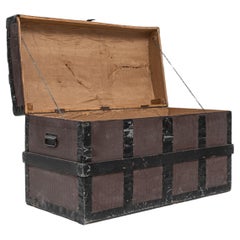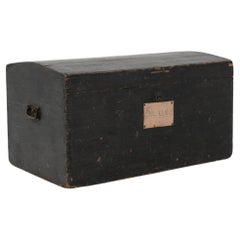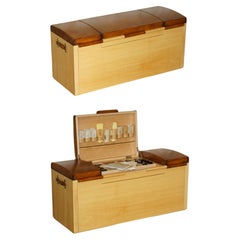French Trunks and Luggage
1
302
12
3
to
32
183
127
317
314
315
26
23
16
3
3
2
1
1
29
40
233
15
99
50
38
11
18
24
16
6
7
8
11
8
7
218
216
210
173
172
827
317
218
153
151
147
20
5
2
1
Place of Origin: French
Goyard Cabin Trunk, Early 20th Century
By Goyard
Located in MARSEILLE, FR
Goyard cabin trunk covered in canvas with famous "goyardine" 3 chevron patterns making the "Y" letter: it has 3 brass clasps and 2 handles on the sides, studded leather straps, and 4 small wheels attached underneath.
We find the stamp "E Goyard Aîné 233 rue Saint-Honoré Paris", or "Malle Goyard 233...
Category
Early 20th Century Other French Trunks and Luggage
Materials
Fabric, Wood
19th Century French Wooden Trunk
Located in High Point, NC
Discover timeless storage with this 19th Century French Wooden Trunk, a piece steeped in history and rustic charm. Crafted from solid wood, this tr...
Category
19th Century Antique French Trunks and Luggage
Materials
Wood
19th Century French Wooden Trunk
Located in High Point, NC
This 19th-century French wooden trunk embodies the essence of antique elegance and storied craftsmanship. With its deep, black finish and robust wo...
Category
19th Century Antique French Trunks and Luggage
Materials
Wood
19th Century French Wooden Trunk
Located in High Point, NC
Step back in time with this authentic 19th-century French wooden trunk, a captivating piece that brings history and character to your home decor. T...
Category
19th Century Antique French Trunks and Luggage
Materials
Wood
19th Century French Wooden Chest
Located in High Point, NC
This 19th Century French Wooden Chest is a treasure trove of antiquity, offering a storied piece to store your cherished belongings. ...
Category
19th Century Antique French Trunks and Luggage
Materials
Wood
1 OF 1 HERMES PARIS JOHN LOBB EXTRA LARGE SHOE TRUNK HAND DYED LEATHER PANELs
By John Lobb, Hermès
Located in GB
Royal House Antiques
Royal House Antiques is delighted to offer for sale this absolutely stunning, 1 of 1, Hermes Paris made for John Lobb shoe trunk and care kit with all the origi...
Category
Late 20th Century Art Deco French Trunks and Luggage
Materials
Leather, Beech
Vintage LOUIS VUITTON MARMOTTE Sample Box
By Louis Vuitton
Located in Victoria, BC
Here is a wonderful Vintage LOUIS VUITTON MARMOTTE Sample Box. Made from composite material and reinforced with studded leather, this box was used to store samples in order to be abl...
Category
1930s Vintage French Trunks and Luggage
Materials
Composition
19th Century French Bleached Oak Trunk
Located in High Point, NC
A beautiful bleached oak chest, from circa 19th Century France. Refined in its old age, this antique yet stylish chest offers a roomy storage compartment and a charming exterior. Spa...
Category
19th Century Antique French Trunks and Luggage
Materials
Wood
1750s French Bleached Oak Trunk
Located in High Point, NC
Transport your space to the 1750s with the French Bleached Oak Trunk, a captivating piece that echoes the sophistication of its era. The bottom of the trunk boasts incredible ornate ...
Category
Mid-18th Century Antique French Trunks and Luggage
Materials
Wood
FULLY RESTORED ANTiQUE 1910 LOUIS VUITTON STAMPED & SIGNED MALLE PENDERIE TRUNK
By Louis Vuitton
Located in GB
Royal House Antiques
Royal House Antiques is delighted to offer for sale this absolutely stunning fully restored original Louis Vuitton 1910 steamer wardrobe, Malle Penderie trunk i...
Category
1910s Edwardian Vintage French Trunks and Luggage
Materials
Brass, Copper
FULLY RESTORED ANTiQUE LOUIS VUITTON STAMPED MONOGRAM WARDROBE TRUNK
By Louis Vuitton
Located in GB
Royal House Antiques
Royal House Antiques is delighted to offer for sale this absolutely stunning fully restored original Louis Vuitton steamer small wardrobe Monogram Trunk RRP £55...
Category
1910s Edwardian Vintage French Trunks and Luggage
Materials
Brass, Copper
Original Louis Vuitton Monogrammed Steamer Trunk, Fully Complete with All Pieces
By Louis Vuitton
Located in Shrewsbury, GB
A truly luxurious and a fantastic example of a wardrobe trunk in amazing condition; covered in Louis Vuitton from the first quarter of the 20th century, originally designed for inter...
Category
Early 20th Century Mid-Century Modern French Trunks and Luggage
Materials
Stainless Steel
DECORATIVE PAIR OF RESTORED ANTiQUE LOUIS VUITTON MONOGRAM SUITCASE TRUNKS
By Louis Vuitton
Located in GB
Royal House Antiques
Royal House Antiques is delighted to offer for sale this absolutely stunning pair of fully restored original Louis Vuitton Monogram Suitcase...
Category
1910s Edwardian Vintage French Trunks and Luggage
Materials
Brass
19th Century Leather Trunk with Fleur de Lis
Located in New Orleans, LA
Use this beautiful leather chest at the foot of a bed or under a console for stylish storage.
Category
19th Century Antique French Trunks and Luggage
Materials
Leather
Pair Vintage 1920's, 30's Louis Vuitton Alzer 80 and 70 monogram luggage
By Louis Vuitton
Located in Buffalo, NY
Pair Vintage 1920's, 30's Louis Vuitton Alzer 80 and 70 monogram luggage .Original hardware/detailing with leather handles. Personalized hand pa...
Category
1930s Art Deco Vintage French Trunks and Luggage
Materials
Brass
19th Century Black Leather Trunk on Stand with MX Monogram
Located in New Orleans, LA
Black leather trunk with nailhead decoration in the shapes of hearts and flowers. Also has monogram of MX in a heart in front.
Category
19th Century Antique French Trunks and Luggage
Materials
Leather
19c Leather Trunk on Stand, JMB Monogram
Located in New Orleans, LA
Brown leather trunk on stand with nailhead embellishments. Monogram on top is JMB.
Category
19th Century Rustic Antique French Trunks and Luggage
Materials
Leather, Wood
French Vintage Steamer Trunk in Canvas Covered Wood
Located in LA CIOTAT, FR
A very chic canvas-covered wooden steamer trunk, complete with sturdy leather carrying handles and very attractive vertical wood and brass banding. This wonderful vintage travelling trunk...
Category
19th Century Antique French Trunks and Luggage
Materials
Brass
Vintage Louis Vuitton Dinner Purse. Monogram Canvas, circa 1970s
Located in Copenhagen, DK
Vintage Louis Vuitton dinner purse. Monogram canvas, circa 1970s.
Measures: 24 x 20 cm.
Detachable shoulder strap.
In excellent condition.
Category
1970s Vintage French Trunks and Luggage
Materials
Leather
19th Century French Iron Safe
Located in High Point, NC
Originally used as a safe or strong-box, this antique iron trunk remains a trustworthy vault for treasured possessions. Made in 19th century France,...
Category
19th Century Antique French Trunks and Luggage
Materials
Iron
French 16th Century Coffre, Trunk
Located in Atlanta, GA
A stunning early 16th century Coffre - Trunk from the Bourgogne region of France. Beautifully constructed from very handsome walnut with lovely linen fold detailing, a beautiful lock...
Category
16th Century Antique French Trunks and Luggage
Materials
Walnut
Selection of French Steamer Trunks Goyard and Romand Paris
By Goyard, Paul Romand
Located in Atlanta, GA
Selection of French Art Deco Steamer Trunks, France, circa 1930s. They are a versatile size and can be used as side tables or coffee tables. They are pric...
Category
1930s Art Deco Vintage French Trunks and Luggage
Materials
Metal, Brass
1920's-1930's Louis Vuitton Trunk in Monogram, 80 cm Louis Vuitton Steamer Trunk
By Louis Vuitton
Located in Saint-Ouen, FR
This superb Louis Vuitton steamer trunk features stenciled monogram canvas, deep chocolate color leather trim, LV stamped solid brass locks and studs as well as solid brass side hand...
Category
1920s Vintage French Trunks and Luggage
Materials
Brass
18th Century Oak French Silver Chest Strongbox
Located in Buisson, FR
Beautiful handmade oak silver chest. It was made to hold valuables such as silver coins, jewels or maps. This was the precursor to the modern day safe. It is...
Category
18th Century Primitive Antique French Trunks and Luggage
Materials
Iron
1900s French Wooden Trunk
Located in High Point, NC
This stout trunk crafted out of wood in France circa 1900 features a convex lid that smoothes up the angularity of the case. The white-red stripe painted in the middle of the chest braces it like a ribbon, bringing a vivid contrasting element to the dark chocolate hue of the finish. The original metal hardware and pulls...
Category
Early 1900s Country Antique French Trunks and Luggage
Materials
Metal
17th Century French Walnut Coffer with Brass Hardware
Located in Dallas, TX
A large French walnut coffer with exceptional hardware. This coffer is made of solid pieces of walnut. This piece would be ideal for a large room, behind a sofa, in a hall or stair landing...
Category
17th Century Louis XIII Antique French Trunks and Luggage
Materials
Brass
Small 17th Century, French Coffer or Box in Leather
Located in Buisson, FR
Extremely old box that is covered with leather and metal decorations.
Rare find.
France, circa 1600-1700
Weathered and some losses.
Category
17th Century Antique French Trunks and Luggage
Materials
Leather, Wood
Exceptional French 17th Century Marriage Trunk
Located in Atlanta, GA
An exceptional 17th century Marriage Trunk - Malle - from the Provence region of France. Soundly constructed from wood and clad in leather. Beautifully ...
Category
17th Century Antique French Trunks and Luggage
Materials
Leather
Antique Luis Vuitton Steamer/ Wardrobe Trunk for Restoration
By Louis Vuitton
Located in Bridgeport, CT
Classic age of Travel Luis Vuitton Steamer trunk with the LV monogram and red and white bands. Monogrammed L.R.C., St. Louis MO U.S.A. With old Railway Exp...
Category
Early 20th Century Hollywood Regency French Trunks and Luggage
Materials
Leather, Canvas, Wood
French Art Deco Embossed Crocodile Leather Doctor’s Bag, c. 1920
Located in Boven Leeuwen, NL
Antique French embossed crocodile leather doctors bag / nurse bag c. 1920
The bag is in a nice antique condition after ca. 100 years as you can see on the photo's.
It even has its ...
Category
1920s Art Deco Vintage French Trunks and Luggage
Materials
Leather
Art Deco Ribbed Leather Brown Handbag c. 1920
Located in Boven Leeuwen, NL
Beautiful leather handbag from the Art Deco period, ca. 1920.
A very nice bag for decoration, but you might want to take it to a diner party sometimes.
The ...
Category
1920s Art Deco Vintage French Trunks and Luggage
Materials
Leather
Louis Vuitton, Ave Marceau, 78bis, Paris, 1950's Suitcase
Located in Montreal, QC
Rigid suitcase in monogram canvas, lozinated edges, corners and closure in brass. Bought from Saks Fifth Ave New-York.
Category
1950s Mid-Century Modern Vintage French Trunks and Luggage
Materials
Leather
Extremely Rare, 20th Century Arthur Conan Doyle Goyard Desk Trunk
By Goyard
Located in Hong Kong, HK
Extremely rare, Goyard Desk Trunk
Arthur Conan Doyle (1859-1930) was a British doctor and writer famous the world over for his Sherlock Holmes series of...
Category
Early 20th Century French Trunks and Luggage
Materials
Brass
Little Art Deco Ribbed Leather Black Handbag, circa 1920
Located in Boven Leeuwen, NL
Super sweet little leather bag from the Art Deco period, circa 1920.
The ladies had their lipstick and gloves in here.
A very cute bag that is great to use for decoration, but you ...
Category
1920s Art Deco Vintage French Trunks and Luggage
Materials
Leather
Goyard Goyardine Steamer Wardrobe Trunk, 1912, France
By Goyard
Located in Biebergemund, Hessen
Early 1910s very rare Goyard wardrobe trunk handmade in France. This was the biggest trunk that was ever made by Goyard. The trunk is in very good condition with nice patina. Perfect...
Category
Early 20th Century Country French Trunks and Luggage
Materials
Brass
Little Art Deco Ribbed Leather Brown Handbag C. 1920
Located in Boven Leeuwen, NL
Super sweet little leather bag from the Art Deco period, ca. 1920.
The ladies had their lipstick and gloves in here.
A very cute bag that is great to use for decoration, but you mi...
Category
1920s Art Deco Vintage French Trunks and Luggage
Materials
Leather
Amazing Highly Carved 19th Century French Trunk
Located in Hopewell, NJ
Gorgeous highly carved oak trunk featuring rich Renaissance figures with lots of floral and leaf motifs. The top opens to reveal plenty of storage, while closed it may be used as a ...
Category
1860s Renaissance Antique French Trunks and Luggage
Materials
Oak
Beige Canvas Cabin Trunk by Innovation
Located in Barcelona, ES
1940s cabin trunk manufactured by Innovation.
It is made all in wood and canvas, it has wooden black painted bars with metal protections and leather and i...
Category
20th Century French Trunks and Luggage
Materials
Metal, Iron
Traveling Jewelry Case in Shagreen Brass w/Leather Handles by R&Y Augousti
By R & Y Augousti
Located in New York, NY
As an ode to vintage steamer trunks, R&Y Augousti revisits this old-world piece in a modern context by recreating their own version inlaid in th...
Category
21st Century and Contemporary Art Deco French Trunks and Luggage
Materials
Brass
17th Century Leather Trunk, 17th Century Chest
Located in Saint-Ouen, FR
Very unique piece,this 17th century trunk features brown leather and a wonderful job of flowers drawing made with little brass studs.
It has got 2 iron side handles and an iron lock...
Category
17th Century Antique French Trunks and Luggage
Materials
Leather, Wood
French Trunk or Coffee Table in Black Canvas, Leather and Wood
Located in Barcelona, ES
Beautiful black canvas and leather trunk as coffee table / side table. France, 19th century.
This trunk is all made in wood covered with black canvas. It has wooden bars, leather pr...
Category
20th Century French Trunks and Luggage
Materials
Brass
18th Century French Louis XVI Walnut Coffer or Blanket Chest
Located in Houston, TX
18th century French Louis XVI walnut coffer or blanket chest.
18th century French Louis XVI, Renaissance or Gothic style walnut coffer or chest from Dijon.
This gorgeous coffer, trun...
Category
18th Century Louis XVI Antique French Trunks and Luggage
Materials
Walnut
Charlotte Perriand Luggage Racks-Stools for Les Arcs
By Charlotte Perriand
Located in Los Angeles, CA
Classic luggage rack or stool by Charlotte Perriand for Les Arcs. Tubular chrome frame with pine slats. Wood in original vintage condition. Could also be used as a side table. Fantas...
Category
1970s Vintage French Trunks and Luggage
Materials
Chrome
Unmatching Pair of French Suitcases in Vellum and Leather
Located in Barcelona, ES
Beautiful set of two suitcases made of cream leather and parchement, France, 1930s-1940s.
Metal locks and studs and leather handles.
The small one is made in vellum.
The large one...
Category
20th Century French Trunks and Luggage
Materials
Metal
Leather Travel Trunk with Handles, France, 1940s
Located in Barcelona, ES
Beautiful leather trunk manufactured at the mid-20th century period in France.
It has very nice proportions, handles at both sides and 2 large solid metal rings at the back enable t...
Category
Mid-20th Century Mid-Century Modern French Trunks and Luggage
Materials
Metal, Iron
French Parchment / Vellum Suitcases as Side Table
By Innovation
Located in Barcelona, ES
A set of high quality French luxury vellum suitcases. France, 1920-1930s.
Made in wood and parchment with brass studs and lock plates in brass and leat...
Category
20th Century French Trunks and Luggage
Materials
Brass
French Mediterranean Canvas and Wood Travel Trunk, 1930s
Located in Barcelona, ES
A vintage wood and textile canvas vintage trunk manufactured at the Art Deco period. It is patinated in ivory color with hotel labels, wooden bars, metal protections and leather han...
Category
1930s Bohemian Vintage French Trunks and Luggage
Materials
Metal
17th Century French Leather Coffer with Nailhead Detail
Located in Houston, TX
17th century French leather coffer, chest or trunk with nailhead detail from burgundy on newer wooden base.
Category
17th Century Renaissance Antique French Trunks and Luggage
Materials
Brass
French Art Deco Dome-Top Box, Miniature Parquetry Work
Located in Port Chester, NY
Practical size for holding papers or some firewood, but most notable for the very fine marquetry work, and the color and patina. Very attractive piece for storage. Any minor losses ...
Category
1930s Art Deco Vintage French Trunks and Luggage
Materials
Wood
French 18th Century Leather Trunk
Located in Atlanta, GA
A wonderful mid-18th century leather clad trunk - coffee from the South of France. Fabulous patina.
Category
18th Century Antique French Trunks and Luggage
Materials
Leather
Traveling Jewelry Case in Cream Shagreen Brass W/Leather Handles by R&Y Augousti
By R & Y Augousti
Located in New York, NY
As an ode to vintage steamer trunks, R&Y Augousti revisits this old-world piece in a modern context by recreating their own version inlaid in th...
Category
21st Century and Contemporary Art Deco French Trunks and Luggage
Materials
Brass
Luxury French Leather Suitcase by Gustave Keller
By Gustave Keller Freres
Located in Barcelona, ES
An exquisite Art Deco period luxury brown leather gentleman's suitcase. Manufactured by Gustave Keller (Keller Frères), 1920s-1930s.
Signed 'Gustave Keller. Av. Matignon 18, Paris' at the front part.
Rare find.
This outstanding top quality leather suitcase was manufactured by Gustave Keller Freres. Designed to be used as gentlemen's vanity travel suitcase.
Brown leather with gold plated lock plates and garnet leather inside.
The key is available. The interior is in good condition, fresh and clean. The original vanity set is missed.
A perfect addition for decorative purposes or as elegant storage box and also beautiful as end / bedside table placed on a pedestal or on other suitcases.
Great gift idea!
The Fendi Zucca Pattern Suitcase shown at the images is avaliable at our 1stdibs marketplace.
Measures: 66 cm W x 45 cm D x 16 cm H
About Gustave Keller:
The company was founded in 1856 by Gustave Keller, whose simple yet elegant sets and accessories were immediately appreciated around the worl for their premium quality.
Keller was awarded with a gold and a silver medal at the 1867 and 1878 Paris World Exhibitions. After 1878, the Keller brothers succeeded the father and started producing silverware, which was again rewarded at the 1889 and 1900 world fairs respectively, with a gold medal and a Grand Prix.
In his beginnings established at 65 rue de Turbigo in Paris, Keller moved their shop and workshop to 22 rue Joubert in 1891. In 1929, the shop was mentioned as trading from 18 Avenue Matignon and was still active possibly as late as 1947.
In 1889, Lucien Falize wrote that "everything stamped Keller is good" (the firm was later known as "Keller fils et gendre successeurs").
Keller Company attracted brilliant and international customers and was appointed official supplier of several courts (Spain, Russia, Greece and Romania). The Russian Court was an important client and from 1897, the last Tsar regularly purchased artifacts from the Parisian silversmith.
From the 1900s the firm was also commissioned to produce several important cups and trophies for the Principality of Monaco.
The Zucca pattern Fendi hard suitcase...
Category
Early 20th Century Art Deco French Trunks and Luggage
Materials
Gold Plate, Brass
Early 20th Century Vellum Suitcase
Located in Brecht, BE
charming suitcase, from the 1920's
Category
Early 20th Century French Trunks and Luggage
Materials
Leather
French Steamer Trunk By Aux Etats Unis
Located in Essex, MA
Canvas and leather and wood trim with brass fittings. Provenance ; John Gardner Coolidge. He was the nephew of Isabella Steward Gardner. John was an American diplomat. His summer hom...
Category
Early 20th Century French Trunks and Luggage
Materials
Other
Pocketbook Fine Quilted Black Leather with Extra Long Chain Classic Chic
By Chanel
Located in Westport, CT
Black fine soft leather, channel design quilted large envelope shaped, double length long chain strap with leather woven, in very fine condition, top quality clean interior three com...
Category
Mid-20th Century Mid-Century Modern French Trunks and Luggage
Materials
Metal
Outstanding, French 17th Century Marriage Trunk
Located in Atlanta, GA
An outstanding 17th century marriage trunk Malle from the South of France. Wonderfully constructed from wood enveloped with richly patina'd leather. The...
Category
17th Century Antique French Trunks and Luggage
Materials
Leather
French Alp, folk art , Trunk
Located in grand Lancy, CH
French Alp, folk art , trunk with a very nice patina
Category
Early 1900s Antique French Trunks and Luggage
Materials
Wood
1920s French Antique Suitcase
Located in High Point, NC
Embrace the nostalgia of early 20th-century travel with this 1920s French Antique Suitcase, a piece that perfectly captures the elegance and craftsmanship of the era. This vintage su...
Category
Early 20th Century French Trunks and Luggage
Materials
Leather
Recently Viewed
View AllMore Ways To Browse
Leather Steamer Trunks
Ships Trunk
Trunk Spain
1920 Trunks
Chinese Wood Trunk
Inside Antique Trunks
Antique American Trunk
Leather Trunk Coffee Tables
Antique Trunks And Boxes
Art Deco Trunk
Small Trunks
Travel Trunk Wood
Vintage Cases And Trunks
Vintage Trunk Large
Louis Vuitton Art Of Living
Small Antique Wood Trunk
Small 19th Century Trunk
Antique Trunk Makers





